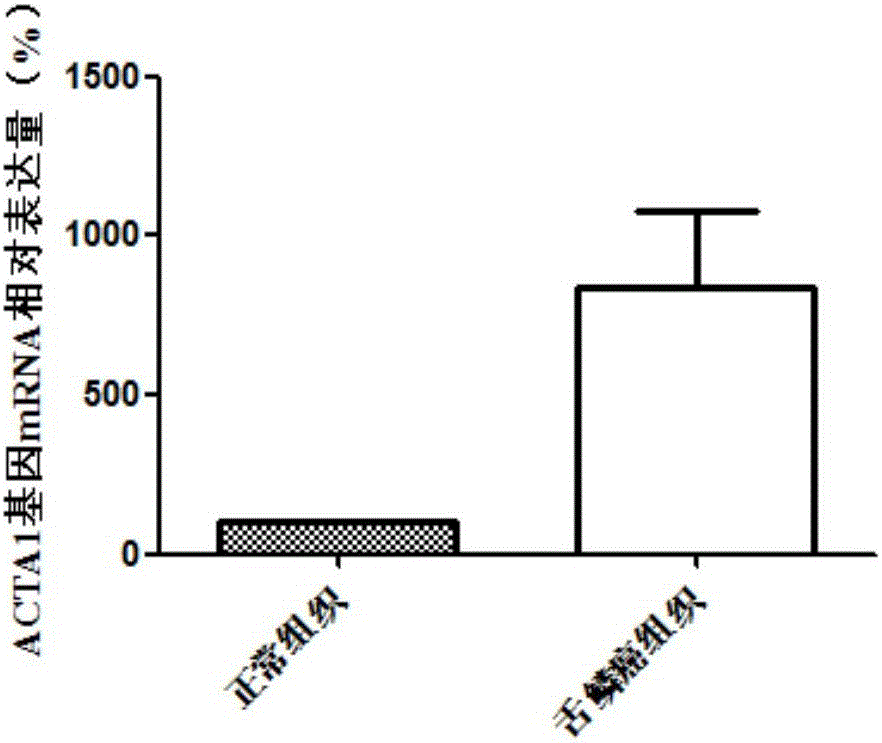Use of ACTA1 as diagnosis and treatment marker of tongue squamous cell carcinoma
A tongue squamous cell carcinoma, substance technology, applied to ACTA1 gene in the diagnosis and treatment of tongue squamous cell carcinoma, can solve the problem that the molecular mechanism is not clear.
- Summary
- Abstract
- Description
- Claims
- Application Information
AI Technical Summary
Problems solved by technology
Method used
Image
Examples
Embodiment 1
[0065] Example 1 Differential expression of ACTA1 gene
[0066] 1. Experimental materials
[0067] 5 tissue samples of tongue squamous cell carcinoma were obtained from oral and maxillofacial surgery patients, including 2 cases of well-differentiated squamous cell carcinoma, 2 cases of moderately differentiated squamous cell carcinoma, and 1 case of poorly differentiated squamous cell carcinoma; including 2 males and 3 females. At the same time, each case of cancerous tissue was selected as the normal tissue at >5cm around the cancerous tumor as its own control. All patients had not undergone chemotherapy, radiotherapy, biological therapy and other treatments for tumors before seeing the doctor. A part of the tissue was immediately stored in liquid nitrogen after collection.
[0068] 2. RNA extraction and cDNA synthesis
[0069] Total RNA was extracted with Trizol RNA reagent (Invitrogen Company), and total RNA was identified by UV spectrophotometer (ND-1000, NanoDrop Company...
Embodiment 2
[0078] Example 2 Verification of Differentially Expressed Genes in Large Samples
[0079] 1. Research object
[0080] According to the method of Example 1, 45 cases of tongue squamous cell carcinoma tissue samples and 50 cases of normal tissue samples were collected.
[0081] 2. RNA extraction and cDNA synthesis
[0082] RNA extraction and cDNA synthesis were performed according to the method in Example 1.
[0083] 3. RT-PCR
[0084] The primers were designed by the primer design software Primer 5.0, and synthesized by Dalian Bao Biological Company and Shanghai Yingjun Company. The primer sequences used for ACTA1 gene and internal reference gene are as follows:
[0085] ACTA1 gene primer sequence
[0086] 5'-ATTCACGAGACCACCTAC-3' (SEQ ID NO.1),
[0087] 5'-ATGACGTTGTTGGCATAC-3' (SEQ ID NO.2);
[0088] GAPDH gene primer sequence
[0089] 5'-AAGGTCGGAGTCAACGGATTTG-3' (SEQ ID NO.3),
[0090] 5'-CCATGGGTGGAATCATATTGGAA-3' (SEQ ID NO. 4).
[0091] 1 μl of cDNA product was...
Embodiment 3
[0100] Example 3 Determination of the expression of ACTA1 gene on the proliferation ability of tongue squamous cell carcinoma cells
[0101] 1. Interference with ACTA1 gene expression
[0102] 1.1 siRNA synthesis
[0103] Design and synthesize siRNA sequence siRNA-ACTA1 according to the mRNA sequence of ACTA1 gene:
[0104] The sense strand is 5'-AUGAUCUUGAUCUUCAUGGUG-3' (SEQ ID NO.5);
[0105] The antisense strand is 5'-CCAUGAAGAUCAAGAUCAUCG-3'(SEQ ID NO.6),
[0106] The above siRNA sequences and the negative control siRNA sequence (siRNA-NC) (the negative control siRNA has no homology to the ACTA1 gene sequence) were provided by Shanghai Gemma Pharmaceutical Technology Co., Ltd.
[0107] 1.2 Culture and transfection of tongue squamous cell carcinoma cells
[0108] Human tongue squamous carcinoma cell line HN4 was cultured in DMEM / F12 medium containing 10% FBS, 100 U / m L penicillin and 100 μg / m L streptomycin. All cells were placed in 5% CO 2 in a 37 °C cell culture inc...
PUM
 Login to View More
Login to View More Abstract
Description
Claims
Application Information
 Login to View More
Login to View More - R&D
- Intellectual Property
- Life Sciences
- Materials
- Tech Scout
- Unparalleled Data Quality
- Higher Quality Content
- 60% Fewer Hallucinations
Browse by: Latest US Patents, China's latest patents, Technical Efficacy Thesaurus, Application Domain, Technology Topic, Popular Technical Reports.
© 2025 PatSnap. All rights reserved.Legal|Privacy policy|Modern Slavery Act Transparency Statement|Sitemap|About US| Contact US: help@patsnap.com



